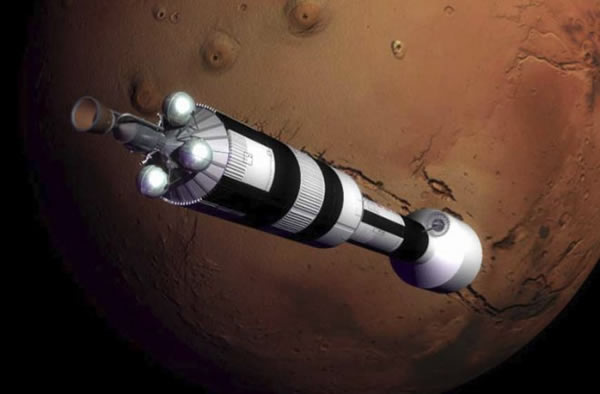Nuclear Thermal Rocket: A Misunderstood Beast
Artist's impression of the Nuclear Engine for Rocket Vehicle Application (NERVA) spacecraft arriving in Mars orbit.
Icarus Interstellar is a nonprofit corporation dedicated to accomplishing interstellar flight by 2100. The Center for Space Nuclear Research (CSNR) is a focus for research and development of advanced space nuclear systems, including power and propulsion systems, and radioisotope power generators. Icarus Interstellar have recently partnered with CSNR to bring you a series of articles aimed at exploring the potential uses of nuclear power for space propulsion and power generation for space missions.
Recently, an international marine life census concluded that over 200,000 organisms call Earth's oceans their home. Remarkably, a handful of those life forms happily exist at depths and temperatures where life was once thought to certainly perish.
Yet despite the fact that people have been intimately engaged with the seas for thousands of years, we still know very little about many of these creatures, discovering new ones on a routine basis. If even the darkest, coldest, and seemingly oxygen-depleted regions of our own world are capable of harboring life, perhaps life may be flourishing elsewhere in the solar system; for example, within the oceans of the Saturnian moon Titan.
Only recently have we begun to explore the surfaces of distant worlds, and as the 21st century unfolds, ambitious plans abound for undertaking such future ventures.
However, many of these plans are reliant upon technology that is realistically quite some time away from implementation, or even purely theoretical at this juncture.
Propulsion systems employing fusion power or matter/anti-matter collisions are all promising conduits for efficient and timely inter-solar and deep-space exploration, but are thus far undeveloped or unfeasible at the present time. Even the promise of ion propulsion, having successfully been demonstrated in a handful of robotic spacecraft (such as NASA's Dawn and the Japanese Hayabusa mission), does not offer an immediately viable, large-scale solution.
Yet as we aim beyond sending humans to Earth's moon, the risk for exploratory stagnation is high as traditional chemically-fueled rockets (utilized in every manned space vehicle from the Saturn V to the recently retired Space Shuttle) are unsuitable for long-distance, heavy payload missions.
A traditional chemical rocket trip to our moon takes about three days, covering some 238,000 miles. By comparison, Saturn's most promising lunar body resides nearly 4,000 times further away at over 790 million miles from Earth. However, despite the chasm between traditional and theoretical propulsion systems, deep space exploration need not grind to a halt as a stopgap propulsion system already exists.
Fully within the grasp of modern day technology and capable of fulfilling these immediate needs, are Nuclear Thermal Rockets (NTRs).
The idea of employing nuclear fission rockets for space exploration has been around for over half a century. In fact, President John F. Kennedy originally expressed his support of the government fission rocket project 'Rover/NERVA' as the step after the Apollo program during his famous Congressional moon speech in 1961.
During the mid-20th century, the NERVA program succeeded in proving, through ground-based testing, that NTR propulsion systems could provide a safe and efficient method for sending payloads greater than small exploratory probes into the outer reaches of our solar system. Unfortunately, little progress toward implementation has been made since then, as a cloud of misunderstanding slowly settled over the idea of utilizing nuclear technology within the space program.
Employing NTR rockets is a critical next-step toward sending human explorers or larger robotic laboratories to distant worlds such as Titan or Mars. Certainly, humanity has succeeded in launching probes to Saturn, Jupiter, and beyond with just chemical rockets, but the key limiting issue is mass.
The mass of those probes was significantly less than that inherent to, for example, a deep ocean Titan explorer. The power available by chemical rocket propulsion simply maxes out (and fuel weight becomes an issue), making such distant, heavy-voyages all but infeasible. Nuclear fission propulsion is ideally suited to provide for this need, as it is both superior to chemical rocket fuel and readily developable.
Traditional chemical rocket engines derive power from the resultant chemical reaction between fuel elements -- usually hydrogen and oxygen. However, the maximum amount of exhaust velocity generated by such an engine is severely limited due to the fact that the fuel is utilized to provide both the heat and the thrust. In contrast, a Nuclear Thermal Rocket maintains a separation between heat source and fuel, which allows for greater exhaust velocity to be achieved with less propellant.
Jan 31, 2013 01:18 PM ET by Steve Summerford, Icarus Interstellar












